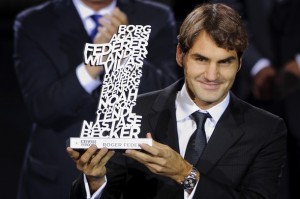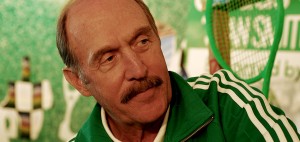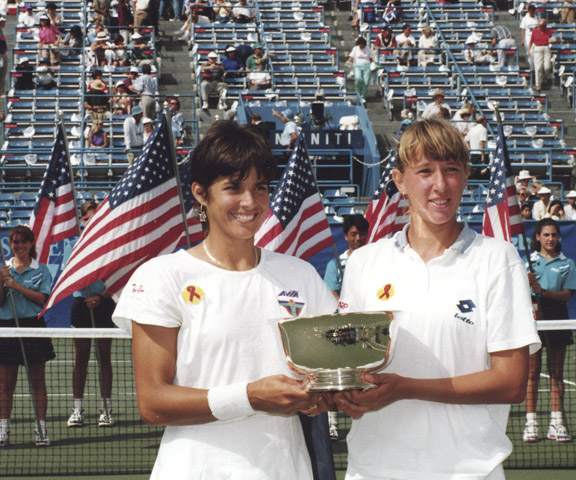By Randy Walker
@TennisPublisher
So August 16 is the birthday of Tony Trabert, who, for those young enough to not know, was one of the all-time great American tennis players. Trabert won five major singles titles, five major doubles titles and perhaps closest to his heart were being the leading member of the U.S. Davis Cup team for many years as a player and captain, leading the team as a player to an historic win over Australia in 1954 and as captain to wins in 1978 and 1979.
Trabert actually was two match wins away from winning the Grand Slam in 1955, winning Wimbledon, the U.S. and French Championships, but lost in the semifinals to start the year at the Australian Championships. For years he was the voice of American tennis as the commentator for the U.S Open on CBS alongside Pat Summerall and he also served for many years as the President of the International Tennis Hall of Fame.
One of things that I always also associate with Tony Trabert is….the city of Cincinnati. Which is why the Cincinnati Open should pay homage to this all-time tennis great and name its stadium court for Trabert.
Trabert was born there on August 16, 1930 and grew up there, attending Walnut Hills High School. He stayed in Cincinnati for college, going to the University of Cincinnati, incredibly playing on both the tennis and basketball teams. He won the NCAA singles title for the Bearcats in 1951 before he served in the U.S. Navy during the Korean War (although he served on the USS Coral Sea in the Mediterranean) and then touring the world in tennis and winning 56 career amateur singles titles.
I was reminded of Trabert’s birthday by my former U.S. Tennis Association colleague Mark Preston, also the former long-time writer and reporter for Tennis Magazine. Preston wrote an homage on his Facebook page, along with photos of he and Trabert and an personally autographed copy of Sports Illustrated with Trabert on the cover from the 1950s. “Tony Trabert wasn’t just one of the greatest champions ever to play the sport of tennis, but also one of the grandest and most gracious gentlemen ever to walk this earth,” wrote Preston. “I was incredibly fortunate to call him my dear friend. I miss him a lot, particularly today, on his birthday, when we always made a point of connecting to catch up. A quick phone call invariably turned into an hour-long back and forth of jokes and stories and lots of love. Happy heavenly birthday, my friend. I’m sure you’re working on getting us a table… ”
I responded to the post, writing, “I threw this out on Twitter/X earlier this week that the Cincinnati Open should name their Stadium Court after Tony, who was the greatest tennis player to ever come out of Cincinnati, and, of course, was not only one of the all-time great player but, arguably on par with Roger Federer, as one of classiest gentlemen in the sport. Cincinnati is one of the most historical events in American tennis but it hardly exudes or celebrates its history, so this can be a step in that direction and certainly honor one of the legends in American tennis.”
The Cincinnati Open is one of the four biggest tennis tournaments in the United States and one of the 10 biggest in the world. It has played since 1899, making it also one of the oldest tournaments in the world and the longest running tennis event in the United States played at the same city (remember, the modern-day U.S. Open started in Newport, Rhode Island before moving to New York in 1915.) Full confession is that I have never been on-site to the Cincinnati Open, but I don’t get much of a vibe from afar/on television of the history of the tournament. For example, the U.S. Open is played at the Billie Jean King USTA National Tennis Center and the stadium is named for Arthur Ashe. There is also the Arthur Ashe Commemorative Garden and the U.S. Open Court of Champions, that honors the all-time greats in the history of the event. There is also a statue honoring Althea Gibson on the grounds as well. When TV coverage goes to or comes out of commercial at the U.S. Open, you usually catch a glimpse of some of these historical commemorations as part of the TV coverage.
At the Cincinnati Open, which is technically played in the town of Mason, Ohio, you usually only see scenes of roller coasters from the nearby King’s Island Amusement Park, which, with all respect, doesn’t really exude any feelings of reverence or historical significance for the tennis demographic. (Although 11-year-old kids probably are excited about that). Wouldn’t it be great to have a statue of Trabert on site – and the court in his name to match – to show off and offer more talk about the legacy of tennis in Cincinnati and of this great citizen of Ohio? (Rather than there be stories about the Applebees at the tournament as Ben Rothenberg wrote years ago here: https://www.nytimes.com/2014/08/16/sports/tennis/applebees-a-suburban-staple-for-cincinnati-masters-players.html and what seems to be something that many people talk about in relation to the Cincinnati event.) Having commentators refer to “Next on Trabert Stadium….is Carlos Alcaraz against Gael Monfils” rather than just using the generic term “Stadium?” Events that celebrate its history are just more highly regarded, in my opinion.
For a deeper dive on the Trabert career, here is how tennis historian an Hall of Famer Bud Collins described him as seen in the book “The Bud Collins History of Tennis” (for sale and download here https://a.co/d/34Q5BGq)
Tony Trabert
Hall of Fame—1970
One of the finest seasons ever achieved was the 1955 of Tony Trabert, who won three of the four singles majors—French, Wimbledon and U.S.—and two of the doubles, Australian and U.S., earning the No. 1 peak. Triplers are rare, but none of them won more than 100 singles matches or 30 singles and doubles titles as Tony did that year.
Within the most productive season for an American man were 18 singles triumphs (of 23 tournaments)—106-7, with a 36-match winning streak—plus 12 doubles titles alongside Davis Cup teammate Vic Seixas. Amassing 13 U.S. titles in singles and doubles, he was one of two Americans (the other, Art Larsen) to win singles championships on all four surfaces. Other than grass at Forest Hills, he won the 1955 Indoor over Ham Richardson, 11-13, 7-5, 9-7, 6-3; the 1953 Hard Court over Tom Brown, 6-4, 11-9, 6-4; the 1951 Clay Court over Larsen, 6-8, 2-6, 6-4, 6-3, 8-6, and, 1955, over Bernard Bartzen, 10-8, 6-1, 6-4. But Tony stands alone in victoriously traveling that surface route in doubles, too. Alas for Trabert, a semifinal defeat by Ken Rosewall at the 1955 Australian may have cost him a Grand Slam.
An exceptional athlete, Marion Anthony Trabert was born Aug. 16, 1930, in Cincinnati where he grew up. He was a standout basketball regular for the University of Cincinnati, for which, as an All-American, he also won the U.S. Intercollegiate singles in 1951. Traditionally the French Championship has been the most difficult battleground for American men. Tony won five titles at Roland Garros, notably the singles in 1954, over Art Larsen, 6-4, 7-5, 6-1, and 1955, over Swede Sven Davidson, 2-6, 6-1, 6-4, 6-2. He also won the doubles in 1950 (with Bill Talbert) and 1954-55 (with Seixas). Thirty-four years passed before another American guy followed him, Michael Chang in 1989, and Tony was there as a telecasting witness.
For five years, Trabert was a mainstay of the U.S. Davis Cup team, along with Seixas. In each of those years, 1951-55, the Yanks reached the challenge round final against Australia. Tony’s best-remembered match may have been a defeat, a tremendous five-set struggle with Lew Hoad on a rainy afternoon in 1953 at Melbourne. Hoad won out, 13-11, 6-3, 2-6, 3-6, 7-5, to tie the series, 2-2, and Rosewall hung onto the Cup, 6-2, 2-6, 6-3, 6-4, over Seixas.
More determined than ever, Trabert and Seixas, led by Capt. Bill Talbert, returned to Australia a year later, where Trabert beat Hoad, 6-4, 2-6, 12-10, 6-3 on opening day. Seixas bumped Rosewall in four. Then, together Vic and Tony busted an American dry spell of four years by taking the doubles from Lew and Ken, 6-2, 4-6, 6-2, 10-8—the only U.S. seizure of the Cup from the Aussies during an eight-year stretch, 1950-57.
Though an attacker with a powerful backhand and strong volley, competitive right-hander Trabert also had exceptional groundstrokes. In winning the U.S. singles twice, 1953 over Seixas, 6-3, 6-2, 6-3, and 1955 over Rosewall, 9-7, 6-3, 6-3—plus Wimbledon in 1955 over Kurt Nielsen, 6-3, 7-5, 6-1—he did not lose a set. Wow. Following the custom of the time, Trabert, as the top amateur, signed on with the professionals to challenge the ruler, Pancho Gonzalez, on a head-to-head tour in 1956. Gonzalez won, 74-27. Trabert was runner-up to Alex Olmedo for the U.S. Pro singles title in 1960, having won the doubles with Rex Hartwig in 1956.
When his playing career ended, Trabert worked as a teaching pro, an administrator for the pro tour, as an astute television commentator on tennis as well as the president of the International Tennis Hall of Fame. In 1976, he returned to the Davis Cup scene as the U.S. captain, leading the Cup-winning teams of 1978 and 1979. He had four years in the U.S. and world’s Top 10: 1951, 1953, 1954, 1955—No. 1 in each, respectively 1953 and 1955—before turning pro. His amateur career was interrupted by service in the U.S. Navy.
MAJOR TITLES (10)—French singles 1954, 1955; Wimbledon singles, 1955; U.S.
singles, 1953, 1955; Australian doubles, 1955; French doubles 1950, 1954, 1955; U.S.
doubles, 1954. OTHER U.S. TITLES (13)—Intercollegiate singles, 1951; Indoor singles,
1955; Clay Court singles, 1951, 1955; Hard Court singles, 1953; Indoor doubles,
1954, with Bill Talbert; 1955, with Vic Seixas; Clay Court doubles, 1951, 1955, with
Hamilton Richardson; 1954, with Seixas; Hard Court doubles, 1950, 1953, with Tom
Brown; Pro doubles, 1956, with Rex Hartwig. DAVIS CUP (As player)—1951, 1952,
1953, 1954, 1955, 16-5 singles, 11-3 doubles; (As Captain)—1953, 1976, 1977, 1978,
1979, 1980. Record 14-3 (2 Cups). SINGLES RECORD IN THE MAJORS—Australian
(4-2), French (18-2), Wimbledon (13-2), U.S. (23-5).




